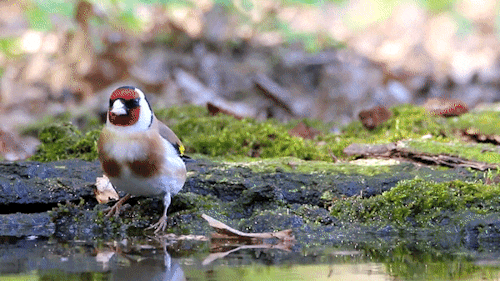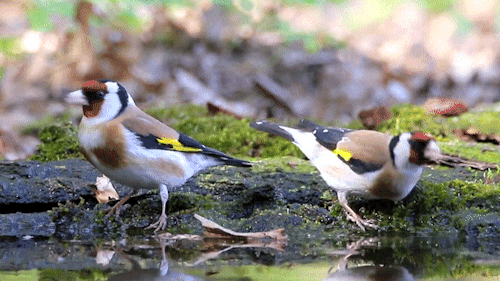Messier Craters In Stereo : Many Bright Nebulae And Star Clusters In Planet Earth’s Sky Are Associated

Messier Craters in Stereo : Many bright nebulae and star clusters in planet Earth’s sky are associated with the name of astronomer Charles Messier from his famous 18th century catalog. His name is also given to these two large and remarkable craters on the Moon. Standouts in the dark, smooth lunar Sea of Fertility or Mare Fecunditatis, Messier (left) and Messier A have dimensions of 15 by 8 and 16 by 11 kilometers respectively. Their elongated shapes are explained by the extremely shallow-angle trajectory followed by an impactor, moving left to right, that gouged out the craters. The shallow impact also resulted in two bright rays of material extending along the surface to the right, beyond the picture. Intended to be viewed with red/blue glasses (red for the left eye), this striking stereo picture of the crater pair was recently created from high resolution scans of two images (AS11-42-6304, AS11-42-6305) taken during the Apollo 11 mission to the Moon. via NASA
More Posts from Eggxecutive-dysfunction and Others



Щегол черноголовый (Carduelis carduelis) - European Goldfinch - Птица 2018 года в Беларуси!, Film Studio Aves


I don’t think my neighbours have noticed the change because all black chickens must look identical to them, but there…..uh, certainly has been a shift in morphology from Yennefer to Wormbecca

I almost forgot 😅 American Crow scribbled real fast, feather shapes are wrong and proportions are wack but it’s already tomorrow and I’m behind as is haha.
Inktober 09

Mountain Bluebird (Sialia currucoides)
© Richard Trinkner
( <= green bean
Is there a bird out there that looks remotely SciFi 🤔 there's gotta be one fella out there with some pattern on them...
So I think you probably want a very futuristic spacey bird, but I'd also like to add some fellas that could easily wander on and about on some alien world and totally fit in Let’s do a list thingy! Four sci-fi birds, whether it’s because they look alien, like a spacecraft or just generally fit the vibe!
1. The Black heron

The black heron, is a member of the Ardeidae occurring in Africa, well known for its peculiar feeding habit, which professionally is referred to as “canopy feeding”. When it does that it uses its wings like an umbrella, creating shade and in turn attracting fish and other prey items. More importantly, its metallic plumage makes it look like a funky UFO.
2. The Andean cock-of-the-rock

First of all here’s what some journalist has to say on these birds (ʰᶦⁿᵗ: ᵗʰᵉʸ’ʳᵉ ʳᶦᵍʰᵗ)

Now, there’s so much to say about cocks-of-the-rock; why they’re called that, why they sound so weird, whatever is going on with their head? Let’s only focus only the latter for this one. First of all, Andean cocks-of-the-rock are sexually dimorphic and while females still look weird, it’s much less extreme on them than it is with males. The thing on their head is a crest, much like that of a tufted titmouse or Eurasian hoopoe, just that it’s shaped like a disk. Overall they’re just fantastic aliens.
3. Any Hornbill

The “horn” on the huge beak of a hornbill, called a casque (not to be confused with the cacique) is there to add strength and/or counterweight to the bills (which is needed, or at the very least helpful when chiselling in bark or hard soil), sometimes also acting as sound chambers to augment vocalisations. Also, considering that casques are usually larger on males than they are on females, and that they can take several years to reach full size, they may be a sign of sexual maturity or status. This - in addition to the many colours a hornbill can have and the wattle makes earth look quite ✨extra-terrestrial✨ (ʸᵉˢ ᴵ ᵏⁿᵒʷ ᵗʰᵃᵗ ᶦˢ ᶜᵒⁿᵗʳᵃᵈᶦᶜᵗᵒʳʸ).
4. The Metallic starling

The metallic starling is an Australasian bird that from a far may seem like just another black bird, however given the right angle and light they show a stunning array of purple and green iridescence. Another very notable feature are their brilliant black eyes. Definitively very spacey, 10/10 birds, would take over a planet if they’d were to try.

Also you asked for patterns! I didn’t include them but perhaps, golden pheasants, sunbitterns or wilson's bird-of-paradise could be of interest to you!

Photo credits: ATLAS1GP, ryanacandee, Bernard DUPONT, Leon Molenaar, TOONMAN_blchin, Jim Boud, cuatrok77, Art G.
Sources: Audubon Society - Watch a Black Heron Fool Fish by Turning Into an Umbrella, Wikipedia The Free Encyclopaedia - Andean cock-of-the-rock, Birdwatching: Your source of becoming a better birder - Julie Craves explains the purpose of hornbills’ huge bills, San Diego Zoo Wildlife Alliance Animals & Plants - Metallic Starling
just came up with a really good 4 word cooking horror story but idk if you guys are ready for it



exploring mountain colors










Australian Night Parrot
The night parrot (Pezoporus occidentalis) is a small parrot endemic to the continent of Australia. It is well known as being one of the most elusive and mysterious birds in the world, with no known sightings of the bird between 1912 and 1979, leading to speculation that it was extinct. The first photographic and video evidence of a live individual was publicly confirmed in July 2013. Another live individual was photographed in March 2017.
Keep reading
-
 thelovelymazza6 liked this · 2 years ago
thelovelymazza6 liked this · 2 years ago -
 ghost-in-a-wasteland liked this · 3 years ago
ghost-in-a-wasteland liked this · 3 years ago -
 diistantpiixels reblogged this · 3 years ago
diistantpiixels reblogged this · 3 years ago -
 biestcallisto reblogged this · 3 years ago
biestcallisto reblogged this · 3 years ago -
 human331279 liked this · 3 years ago
human331279 liked this · 3 years ago -
 torenhoog reblogged this · 3 years ago
torenhoog reblogged this · 3 years ago -
 lukegtr liked this · 3 years ago
lukegtr liked this · 3 years ago -
 g4uze reblogged this · 3 years ago
g4uze reblogged this · 3 years ago -
 g4uze liked this · 3 years ago
g4uze liked this · 3 years ago -
 spiralx liked this · 3 years ago
spiralx liked this · 3 years ago -
 extrasmolboi liked this · 3 years ago
extrasmolboi liked this · 3 years ago -
 sphinxnomore liked this · 3 years ago
sphinxnomore liked this · 3 years ago -
 maybeestonian liked this · 3 years ago
maybeestonian liked this · 3 years ago -
 taelhado liked this · 3 years ago
taelhado liked this · 3 years ago -
 exploringspace reblogged this · 3 years ago
exploringspace reblogged this · 3 years ago -
 exploringspace liked this · 3 years ago
exploringspace liked this · 3 years ago -
 alfssstuff liked this · 3 years ago
alfssstuff liked this · 3 years ago -
 lizalfosrise liked this · 3 years ago
lizalfosrise liked this · 3 years ago -
 g00melo5-art-blog reblogged this · 3 years ago
g00melo5-art-blog reblogged this · 3 years ago -
 nlockett liked this · 3 years ago
nlockett liked this · 3 years ago -
 nlockett reblogged this · 3 years ago
nlockett reblogged this · 3 years ago -
 detaras liked this · 3 years ago
detaras liked this · 3 years ago -
 g00melo5-art-blog liked this · 3 years ago
g00melo5-art-blog liked this · 3 years ago -
 andromeda1023 reblogged this · 3 years ago
andromeda1023 reblogged this · 3 years ago -
 albeo liked this · 3 years ago
albeo liked this · 3 years ago -
 sunny-fog liked this · 3 years ago
sunny-fog liked this · 3 years ago -
 oldone40 liked this · 3 years ago
oldone40 liked this · 3 years ago -
 dis-ass-ter-bye liked this · 3 years ago
dis-ass-ter-bye liked this · 3 years ago -
 johnnyreyna liked this · 3 years ago
johnnyreyna liked this · 3 years ago -
 bentenharuki reblogged this · 3 years ago
bentenharuki reblogged this · 3 years ago -
 bentenharuki liked this · 3 years ago
bentenharuki liked this · 3 years ago -
 53miner53 liked this · 3 years ago
53miner53 liked this · 3 years ago -
 purple-haired-lucifer reblogged this · 3 years ago
purple-haired-lucifer reblogged this · 3 years ago -
 rootecho117 liked this · 3 years ago
rootecho117 liked this · 3 years ago -
 voidwoken liked this · 3 years ago
voidwoken liked this · 3 years ago -
 lovingcuties808 liked this · 3 years ago
lovingcuties808 liked this · 3 years ago -
 andromeda1023 liked this · 3 years ago
andromeda1023 liked this · 3 years ago -
 thund3rlord7 liked this · 3 years ago
thund3rlord7 liked this · 3 years ago -
 eggxecutive-dysfunction reblogged this · 3 years ago
eggxecutive-dysfunction reblogged this · 3 years ago -
 eggxecutive-dysfunction liked this · 3 years ago
eggxecutive-dysfunction liked this · 3 years ago -
 chandraw-thoughts101 liked this · 3 years ago
chandraw-thoughts101 liked this · 3 years ago
